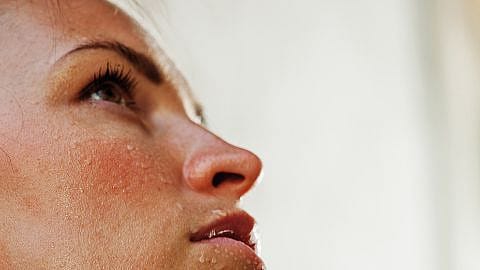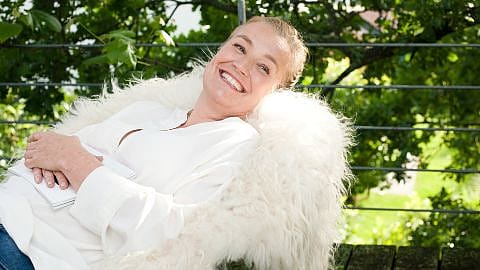How to Enjoy the Sun
Warmth, light, healing – the sun is our source of life. Dr. Brigitte Roesler explains how we can enjoy and respect the power of the sun. As a dermatologist, she knows what to watch out for. In this interview, she answers the most important questions about the sun and our skin. How much sun is good for us? What causes sunburn, and what helps to soothe it?
What happens to our skin when it is exposed to the sun?
The rays of the sun can be good for us. We need sunlight to produce vitamin D and to develop strong bones. The sun’s radiance is a healing force. However, as with any form of radiation, too much can be dangerous, so we must approach it with a certain amount of caution. Sunlight also has a slightly immunosuppressive effect, meaning it can weaken the immune system. That’s why a sun-filled holiday at the beach might trigger an outbreak of oral herpes blisters (cold sores). If you have a cold, it’s generally advisable to avoid excessive sun exposure.
How much sun is good for us, and when should we protect our skin from the sun?
Not all sunlight is the same. The time of day, the season and your geographic location all determine its intensity. Your skin’s natural protection time is shorter when you are outdoors at midday in midsummer, for example, or if you are in the mountains, because UVB radiation increases at higher altitudes. At the sea, UV rays are magnified through their reflection from water. In the tropics, when the sun is at its zenith in summer, UV light has a shorter path through the earth’s atmosphere, making it more intensive.
How long you should spend time in the sun or even avoid it, depends on environmental factors like these, as well as on your skin type.
The UV Index (UVI) is provided by many weather services is a good indicator of the risk of harm from sun exposure. If you’re on holiday or outdoors, you can check the UVI online on your smart phone. An index of 3 to 5 is moderate – if the index is 6 to 7 it’s best to stay indoors through the middle of the day, between 11 am and 3 pm.
Why should we protect our skin against UV radiation – how is it affected by UV light?
Sunlight consists of light waves in different frequencies. Certain parts of this radiation spectrum reach us on earth: invisible, warming, long-wave infrared rays, visible light, and short-wave ultraviolet light. Ultraviolet light is divided into UVA rays, UVB rays and UVC rays
UVA rays penetrate deeper layers of the skin, reaching into the dermis. Excessive exposure to UVA rays advances skin ageing and can lead to the loss of its elasticity. UVA rays cause an “instant tan” that only lasts for a short while. UVA radiation promotes the formation of free radicals, and so indirectly attacks the cells and their molecules (e.g. DNA, proteins). In the long term, this can lead to premature skin aging or skin cancer. Not only that, but UVA radiation causes hyperpigmentation in wounds – during the healing process, the skin around a wound can become darker and remain more visible as a scar.
UVB rays are shorter and higher-energy wavelengths, in comparison to UVA rays, and are primarily responsible for sunburn and a longer lasting tan. UVB rays only reach the upper skin layer (epidermis), but they can damage the nuclei of the skin cells, which can lead to cancer.
Normally, the even shorter-wave and particularly aggressive UVC rays are absorbed by the ozone layer and do not reach us at all. In places where the ozone layer is fragile and permeable, or at high elevations in the mountains, it’s important to wear extra protection, especially appropriate clothing.
How does sunbathing affect skin ageing?
If the skin is exposed to direct sunlight frequently and for long periods of time over many years, this will advance skin wrinkling. This is a reaction to UVA radiation, which attacks the elastic fibres in the dermis, among other things. In addition, this can cause the appearance of cosmetically undesirable pigment irregularities (brown, white or red spots) on the face, neck and forearms.
Which skin types should be particularly careful in the sun?
Our skin is as individual as we are. To make things easier, dermatologists have categorised human skin into different skin types. Each type reacts more or less sensitively to the sun. The so-called “self-protection time” indicates how long your skin can be exposed to the sun – without protection – before getting a sunburn. This time varies in length, depending on your skin type. Being in the mountains, the tropics or by the sea also reduces the self-protection time of your skin.
Babies and children should never be exposed to the sun without protection. Blistering sunburn that occurs before the age of 20 increases the risk of skin cancer.
Our skin is as individual as we are.
Dr. Brigitte Roesler
Determine Your Skin Type
| Skin Type | Skin (before sun exposure)/ Hair | Self-Protection Time/ Recommended SPF |
|---|---|---|
| Type 1 |
Very fair skin, pale, often frecklesReddish to blonde hair |
3-10 min. |
| Type 2 |
Fair skin, sometimes frecklesBlonde to light brown hair |
10-20 min. |
| Type 3 |
Slightly tan or olive skinMedium blonde to brown hair |
15-25 min. |
| Type 4 |
Tan or olive skinDark brown to black hair |
20-30 min. |
| Type 5 |
Light brown to brown skinBlack hair |
40-50 min. |
| Type 6 |
Very dark brown skinBlack hair |
60 min. |
How can I prevent sunburn?
Sunbathing without taking any precautions – simply “baking” under the hot sun at the beach – is particularly harmful to the skin.
If you want to sunbathe, you should do so before 11 am and after 4 pm. For the midday sun, there are three main rules:
1. Avoid direct exposure to the midday sun whenever possible.
2. Wear protective clothing.
3. Apply sunscreen to the skin.
Sunscreen should not be applied sparingly, but generously. The rule of thumb is that two milligrams of sunscreen per square centimetre of skin should be used. Depending on the size of the body, this corresponds to 1.5 to 2 grams for the face and neck, which is approximately equal to a walnut-sized amount of cream.
Another tip is to drink carrot juice on a daily basis, which helps to protect against sunburn “from the inside out”.
If I do get sunburnt, how is it best treated? When is it advisable to see a doctor?
The first thing to do in the case of sunburn is to get out of the sun immediately. In a room protected from sunlight, our body can begin to repair its skin cells.
With a first-degree sunburn, the skin becomes warm and reddened, which is often accompanied by itching or a burning sensation. It helps if you cool the affected area of the skin with a wet towel. Natural remedies such as essences containing arnica and nettle have also proven effective in the treatment of burns. Sprinkle them in diluted form on the wet towel applied to the sunburnt area for soothing relief.
A more serious, second-degree sunburn goes deeper, causing the skin to blister. Depending on the severity of the symptoms, a doctor should be consulted. With third-degree burns, serious damage occurs to all layers of the skin, causing the skin to come off in places, and requires immediate medical attention.
Do household remedies such as quark wraps, yoghurt or coconut oil help with sunburn?
Quark compresses are a great help, cooling the skin for up to four hours. Yoghurt contains more liquid so is not as effective, but if you have nothing else available, you can also make cooling wraps with yoghurt. Simply place a clean cloth on a tea-towel, put the cold quark on the compress, cover this with a second clean cloth, cover the entire thing with another towel and then place on the affected area. Do not apply quark directly to the skin, because it can stick to the skin as it gradually warms.
Oils or greasy creams are not good for sunburn because they can cause heat build-up in the skin. To give the skin extra care, use a light moisturising lotion.
Tip: The gel from the fleshy leaves of the aloe vera plant cools and soothes the skin wonderfully. Simply break a leaf and spread the gel over the affected area on the skin.














